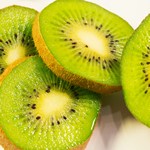National Kiwifruit Day Date in the current year: December 21, 2026
 National Kiwifruit Day, also known as National Kiwi Fruit Day or National Kiwi Day, is celebrated annually on December 21. It recognizes a delicious fruit that is native to China but became known in the rest of the world thanks to its introduction to New Zealand.
National Kiwifruit Day, also known as National Kiwi Fruit Day or National Kiwi Day, is celebrated annually on December 21. It recognizes a delicious fruit that is native to China but became known in the rest of the world thanks to its introduction to New Zealand.Kiwifruit, often shortened to just kiwi and also known as Chinese gooseberry, is the edible fruit of several species of plants in the genus Actinidia, primarily a few cultivars of Actinidia deliciousa (fuzzy kiwifruit). Kiwifruit have a thin and fuzzy light brown skin, light green or golden flesh, and tiny black seeds.
Kiwifruit is native to central and eastern China; its first description in Chinese texts dates to the late Song dynasty (12th century). Kiwifruit wasn’t historically eaten for pleasure. It was harvested in the wild and given as a medicine, so the plant was rarely cultivated. The person responsible for making kiwifruit known outside of China was New Zealand educator Mary Isabel Fraser.
Fraser brought kiwi seeds from her trip to Yichang to visit mission schools in 1904. Alexander Allison, a nurseryman from Whanganui, planted them in 1906, and the vines gave their first fruit in 1910. Horticulturalist Hayward Right developed what is now the most common kiwifruit cultivar around 1924; it was named Hayward to honor its creator.
The first person to plant kiwifruit commercially was Jim MacLoughlin. During World War II, the fruit became popular with American and British servicemen stationed in New Zealand. In the early 1950s, MacLoughlin exported the first shipment of kiwifruit to the United States with the assistance of the New Zealand Fruit Federation.
Interestingly, the name of the fruit has changed several times since its introduction to New Zealand. At first, New Zealanders used the native Chinese name yáng táo. As the popularity of the fruit in New Zealand grew, locals started calling it Chinese gooseberry. In the 1950s, Chinese gooseberry growers and exporters decided to rename it. For a brief period of time, the fruit were called melonette, but in 1959, Turners and Growers adopted the name kiwifruit because the fuzzy brown fruit resembled kiwi, New Zealand’s endemic flightless bird. The new name was universally adopted in the 1970s.
Today, kiwifruit’s native country of China is its top producer, responsible for a little more than a half of global production. It is followed by New Zealand, Italy, Greece, Iran, Chile, Turkey, France, Portugal, and the United States.
The origin of National Kiwifruit Day, celebrated on the first day of astronomical winter in the Northern Hemisphere and summer in the Southern Hemisphere, is unclear, but you shouldn’t let it stop you from observing the holiday and treating yourself to this delicious fruit. You can enjoy kiwifruit raw, add it to various desserts (just remember that kiwi doesn’t mix well with dairy products and gelatin), or event use kiwi to tenderize meat. And don’t forget to post about the holiday on social media with the hashtag #NationalKiwifruitDay.
- Category
- Unofficial Holidays
- Country
- USA
- Tags
- National Kiwifruit Day, observances in the United States, unofficial holidays, food days, kiwifruit, kiwi